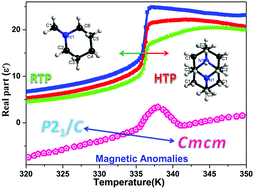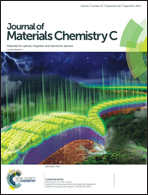Inorganic–organic hybrid switchable dielectric materials with the coexistence of magnetic anomalies induced by reversible high-temperature phase transition†
Abstract
An inorganic–organic hybrid compound that features a zero-dimensional inorganic structural framework, N-methylpiperidinium tetrabromoferrate(III) (compound 1, [C6H14N][FeBr4]), has been reported as a new switchable dielectric material with the coexistence of weak magnetic anomalies. It is noteworthy that 1 demonstrates remarkable dielectric responses, which can be tuned between two distinct dielectric states and reversibly switched by phase transition at ∼340 K (Tc). Its high-dielectric constants are at least 4 times as large as that of the low-dielectric state. Structural analysis reveals that 1 belongs to the monoclinic crystal system with the space group P21/c at room temperature, but transforms into an orthorhombic system with the space group Cmcm above Tc. The disordering of organic cations affords a driving force for high-temperature phase transition in 1 along with its switchable dielectric activities. Besides, weak magnetic anomalies were also found in 1 at the vicinity of its Tc, which should be reminiscent of another possible physical channel to the phase transition. This finding suggests that 1 might be a potential multifunctional material with the coexistence of switchable dielectric bistability and magnetic responses, which opens up new possibilities to develop molecular functional materials.



 Please wait while we load your content...
Please wait while we load your content...